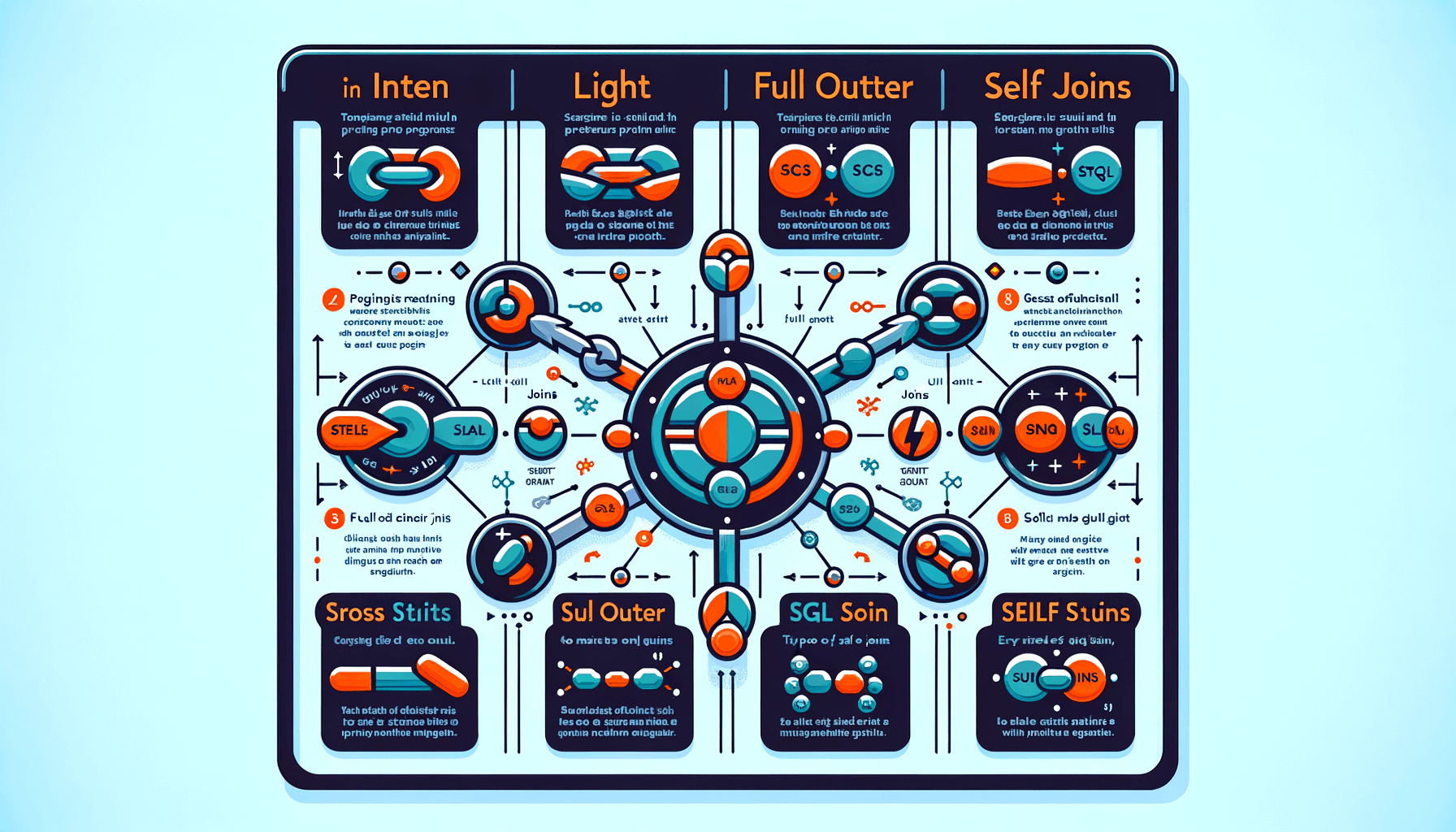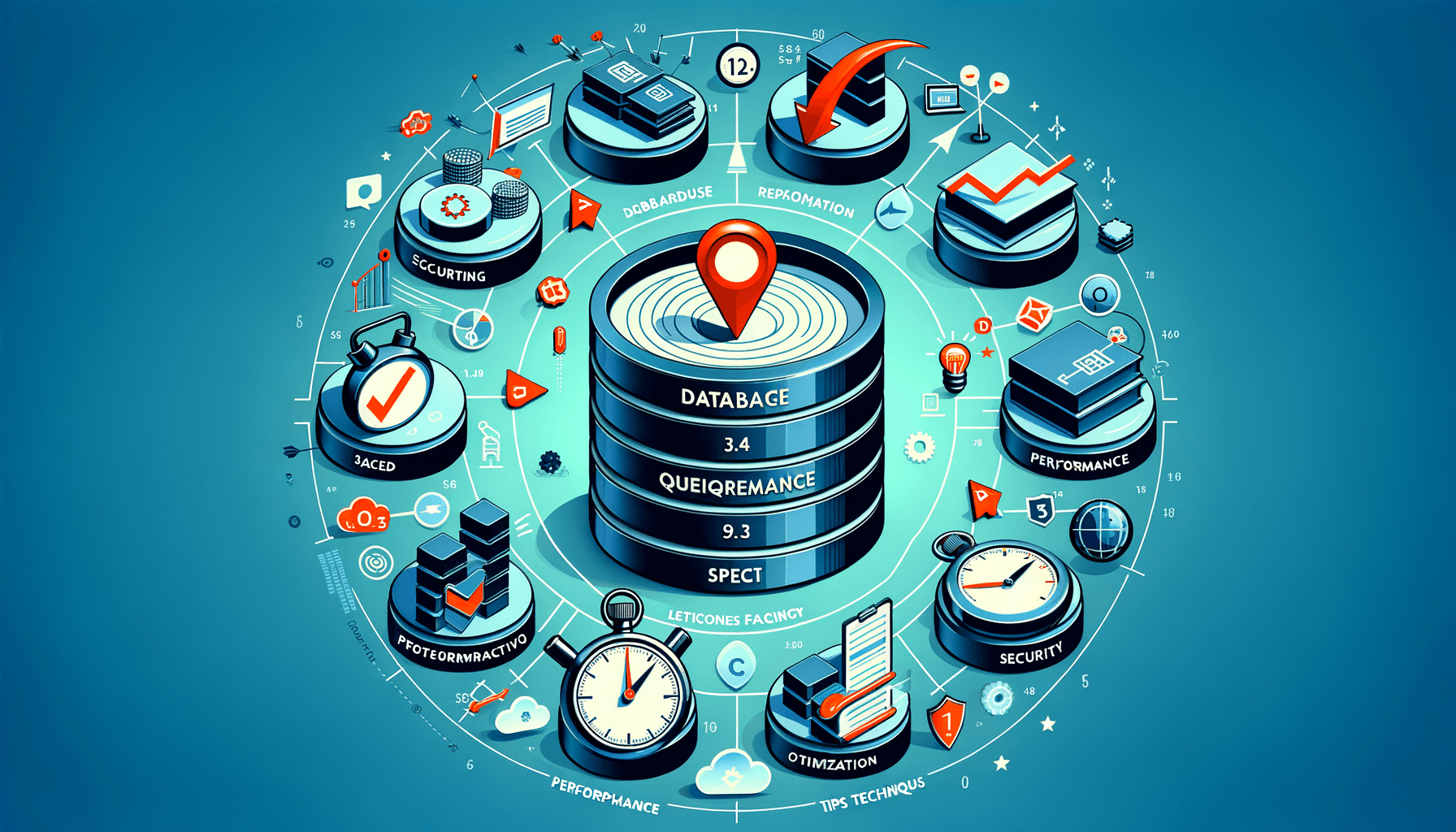A big variety of articles and resources

Mastering Data Management: The Ultimate Guide to SQL Training
 Sia Author and Instructor
Learn SQL
Sia Author and Instructor
Learn SQL
13 minute read
Learning SQL is like gaining a superpower in the world of data. From managing databases to analyzing data, SQL is the tool that helps you do it all. This guide will take you through the basics to advanced techniques, ensuring you master SQL and can use it effectively in real-life scenarios.
Key Takeaways
- SQL is essential for managing and analyzing data in relational databases.
- Understanding SQL syntax and basic data types is the foundation of effective SQL use.
- Advanced techniques like subqueries and joins can greatly enhance your data queries.
- Database design and normalization are crucial for efficient data management.
- SQL skills are valuable for various roles, including data analysis, database administration, and software development.
Foundations of SQL Training
Understanding Relational Databases
In this section, I will introduce you to the concept of relational databases. These databases organize data into tables, which can be linked based on data relationships. Understanding how these tables interact is crucial for mastering SQL. Relational databases are the backbone of many applications, making them essential for data management.
Introduction to SQL Syntax
Here, I will cover the basic syntax of SQL, the language used to interact with relational databases. SQL commands are straightforward but powerful. You'll learn how to write simple queries to retrieve data, as well as more complex commands to manipulate it. Mastering SQL syntax is the first step in becoming proficient in data management.
Basic Data Types and Structures
This part will focus on the different data types and structures you will encounter in SQL. From integers and strings to more complex types like dates and binary data, understanding these is key to effectively managing and querying your data. Knowing the right data type to use can optimize your database's performance and storage efficiency.
Advanced Query Techniques
Mastering Subqueries
Subqueries are queries nested inside another query. They are powerful tools for breaking down complex problems into simpler parts. Understanding subqueries can help you retrieve data that meets specific conditions.
Using Joins Effectively
Joins are used to combine rows from two or more tables based on a related column. There are several types of joins, including INNER JOIN, LEFT JOIN, and RIGHT JOIN. Each type serves a different purpose and can be used to solve various data retrieval problems.
Implementing Set Operations
Set operations like UNION, INTERSECT, and EXCEPT allow you to perform operations on multiple sets of data. These operations can help you combine results from different queries, making your data analysis more comprehensive.
Mastering these advanced query techniques will significantly enhance your ability to manipulate and analyze data effectively.
Data Manipulation and Transformation
Inserting, Updating, and Deleting Data
In SQL, data manipulation is a fundamental skill. You can insert new records, update existing ones, or delete data you no longer need. These operations are crucial for maintaining the accuracy and relevance of your database.
Using Aggregate Functions
Aggregate functions like SUM, AVG, and COUNT help you perform calculations on your data. These functions are essential for summarizing large datasets and gaining insights from your data.
Data Filtering and Sorting
Filtering and sorting data allows you to retrieve specific information from your database. By using WHERE clauses and ORDER BY statements, you can narrow down your results to meet your needs.
Mastering these techniques will enable you to handle data more efficiently and make informed decisions based on accurate information.
Database Design and Normalization
Principles of Database Design
When designing a database, it's crucial to focus on efficiency and accuracy. A well-designed database ensures that data is stored in a way that reduces redundancy and improves data integrity. Effective database design involves understanding the relationships between different data elements and organizing them in a logical structure.
Normalization Techniques
Normalization is a process used to organize a database into tables and columns. The main goal is to reduce data redundancy and improve data integrity. This involves dividing large tables into smaller, more manageable pieces and defining relationships between them. Key steps in normalization include:
- First Normal Form (1NF): Ensure that each table column contains atomic, indivisible values.
- Second Normal Form (2NF): Remove subsets of data that apply to multiple rows of a table and place them in separate tables.
- Third Normal Form (3NF): Eliminate columns that are not dependent on the primary key.
Entity-Relationship Modeling
Entity-Relationship (ER) modeling is a technique used to visually represent the data and its relationships within a database. This model helps in designing a database at the conceptual level. ER diagrams consist of entities (which represent real-world objects) and relationships (which show how these entities interact). By using ER modeling, we can create a blueprint for the database structure, ensuring that all necessary data is captured and properly linked.
A well-structured database not only enhances data integrity but also makes data management more efficient and reliable.
Performance Optimization in SQL
Indexing Strategies
When it comes to speeding up your SQL queries, proper indexing is crucial. Indexes help the database find rows much faster than scanning the entire table. There are different types of indexes, such as B-tree and hash indexes, each suited for specific types of queries. Understanding which type to use can make a big difference in performance.
Query Optimization Techniques
Optimizing your queries can lead to significant performance improvements. Techniques like refactoring SQL queries and using joins effectively can help. For example, using INNER JOIN instead of subqueries can often speed up your queries. Additionally, understanding query execution plans helps refine SQL queries by identifying bottlenecks.
Understanding Execution Plans
Execution plans show how the database engine executes a query. By analyzing these plans, you can identify slow parts of your query and make necessary adjustments. This is especially useful for complex queries involving multiple tables and joins.
Mastering SQL features like dynamic SQL and stored procedures can automate complex tasks and ensure data integrity.
In summary, focusing on indexing, query optimization, and understanding execution plans can greatly enhance your SQL performance.
SQL for Data Analysis
Using SQL for Business Intelligence
SQL is a powerful tool for business intelligence. It helps in extracting meaningful insights from large datasets. By mastering SQL, you can create detailed reports and dashboards that aid in decision-making. Mastering SQL enhances data analysis skills for effective insights.
Advanced Analytical Functions
Advanced SQL functions like window functions and CTEs (Common Table Expressions) allow for complex calculations and data manipulation. These functions are essential for performing in-depth analysis and generating comprehensive reports.
Time Series Analysis
Time series analysis in SQL involves working with date and time data to identify trends and patterns over time. This is particularly useful for forecasting and understanding seasonal variations in data. By using SQL for time series analysis, you can make data-driven predictions and improve business strategies.
SQL is not just a query language; it's a powerful tool for data analysis that can transform raw data into actionable insights.
Security and Compliance in SQL
Implementing Access Controls
When working with SQL databases, it's crucial to set up proper access controls. This means defining who can view, modify, or delete data. User authentication is a key part of this process. By ensuring that only authorized users can access sensitive information, we can protect the database from unauthorized access.
Data Encryption Techniques
Data encryption is another essential aspect of SQL security. Encrypting data both at rest and in transit helps to safeguard it from potential breaches. Using strong encryption algorithms ensures that even if data is intercepted, it remains unreadable to unauthorized parties.
Compliance with Data Protection Regulations
Adhering to data protection regulations like GDPR and HIPAA is not just a legal requirement but also a best practice for maintaining data integrity. These regulations mandate specific measures for data handling, storage, and sharing, ensuring that personal and sensitive information is adequately protected.
Ensuring compliance with these regulations is vital for any organization that handles personal data, as it helps to build trust with users and avoid legal penalties.
SQL in Cloud Environments
Introduction to Cloud Databases
Cloud databases are becoming more popular due to their flexibility and scalability. They allow you to store and manage data without worrying about physical hardware. One key benefit is that you can access your data from anywhere, as long as you have an internet connection.
Migrating Databases to the Cloud
Moving your database to the cloud can seem like a big task, but it offers many advantages. Here are some steps to help you get started:
- Assess your current database setup.
- Choose a cloud service provider.
- Plan the migration process.
- Test the migration with a small dataset.
- Execute the full migration.
- Monitor the new cloud database for any issues.
Managing Cloud-based SQL Databases
Once your database is in the cloud, managing it is crucial. This includes regular backups, performance monitoring, and security checks. Automation tools can help make these tasks easier and more efficient.
Cloud databases offer a modern solution for data management, combining ease of access with powerful tools for maintenance and security.
Practical Applications of SQL
Real-world Case Studies
In our SQL training, we dive into real-world case studies that show how SQL is used in various industries. These examples help you understand the practical applications of SQL and how it can solve real business problems. You'll gain practical learning experience by solving real-world problems.
Hands-on Projects and Exercises
Our course includes hands-on projects and exercises that let you apply what you've learned. These activities are designed to enhance your skills and prepare you for data-related careers. Participants will engage in hands-on exercises and projects, enhancing their skills for data-related careers.
Industry Best Practices
We also cover industry best practices to ensure you are well-prepared for the professional world. This includes tips and techniques for optimizing SQL queries, managing databases, and ensuring data integrity. By learning these best practices, you can become a valuable asset in any data-driven role.
Our SQL training goes beyond basic instruction by incorporating hands-on projects, personalized support, and insights into industry best practices. This approach ensures that you not only learn SQL, but also how to apply it effectively in various professional scenarios, boosting your analytical capabilities and making you a valuable asset in any data-driven role.
Tools and Resources for SQL Training
Popular SQL IDEs and Tools
When diving into SQL, having the right tools can make a world of difference. MySQL Workbench and SQL Server Management Studio are two of the most widely used Integrated Development Environments (IDEs). These tools offer features like query building, database design, and performance tuning, which are essential for mastering SQL.
Online Resources and Communities
The internet is brimming with resources to help you learn SQL. Websites like W3Schools and SQLZoo offer interactive tutorials that are perfect for beginners. For more advanced learners, platforms like Coursera and Udemy provide comprehensive courses. Additionally, community support from Stack Overflow and Reddit's r/SQL can be invaluable for troubleshooting and advice.
Certifications and Career Paths
Earning a certification can significantly boost your career prospects. Certifications like the Microsoft Certified: Azure Data Scientist Associate or the Oracle Certified Professional are highly regarded in the industry. These certifications not only validate your skills but also open doors to advanced career opportunities.
Mastering SQL requires a blend of theoretical knowledge and practical experience. Utilizing the right tools and resources can accelerate your learning journey and help you achieve proficiency faster.
Future Trends in SQL and Data Management
Emerging SQL Standards
In the ever-evolving world of data management, new SQL standards are continuously being developed. These standards aim to enhance the functionality and efficiency of SQL, making it more adaptable to modern data needs. Keeping up with these standards is crucial for anyone looking to stay relevant in the field.
Integration with Big Data Technologies
SQL is increasingly being integrated with big data technologies like Hadoop and Spark. This integration allows for more robust data processing and analytics capabilities. Understanding how SQL interacts with these technologies can open up new avenues for data analysis and business intelligence.
The Role of AI in SQL
Artificial Intelligence (AI) is making its way into SQL, offering features like automated query optimization and predictive analytics. These advancements can significantly reduce the time and effort required for data management tasks.
The future of SQL is not just about managing data but also about leveraging AI to make smarter decisions.
Conclusion
Staying updated with these trends will not only enhance your SQL skills but also make you a valuable asset in any data-driven organization. The future of SQL is bright, and those who adapt will lead the way in data management.
The future of SQL and data management is evolving rapidly. Stay ahead of the curve by exploring the latest trends and technologies. Our expert-led courses are designed to help you master SQL and data management, ensuring you remain competitive in the job market. Don't miss out on the opportunity to advance your career. Visit our website to learn more and start your journey today!
Conclusion
Mastering SQL is a journey that opens up numerous opportunities in the world of data management. This guide has provided you with a comprehensive overview of the essential skills and advanced techniques needed to excel in SQL. By engaging with the various courses and practical exercises, you can build a strong foundation and enhance your capabilities in handling complex database tasks. Remember, continuous learning and practice are key to becoming proficient in SQL. With dedication and the right resources, you can achieve mastery and significantly boost your career in data management.
Frequently Asked Questions
What is SQL and why is it important?
SQL stands for Structured Query Language. It's used to manage and manipulate databases. Knowing SQL is crucial because it allows you to handle large amounts of data efficiently.
Who should learn SQL?
Anyone interested in data management, including students, IT professionals, and data analysts, should learn SQL. It's a valuable skill in many careers.
Do I need any prior knowledge before starting SQL training?
No prior knowledge is required to start learning SQL. Beginners can start from scratch and gradually move to advanced topics.
What are some common uses of SQL?
SQL is commonly used for querying databases, updating records, and managing database structures. It's also used in data analysis and reporting.
How long does it take to learn SQL?
The time it takes to learn SQL varies. Basic concepts can be learned in a few weeks, while mastering advanced techniques may take a few months.
What are the benefits of SQL certification?
SQL certification can enhance your resume, validate your skills, and increase job opportunities. It shows employers that you have a recognized level of expertise.
Can SQL be used with other programming languages?
Yes, SQL can be integrated with languages like Python, Java, and R. This makes it versatile for various applications, including web development and data analysis.
What is the difference between SQL and NoSQL?
SQL databases are relational and use structured query language, while NoSQL databases are non-relational and can store unstructured data. Each has its own use cases and advantages.







